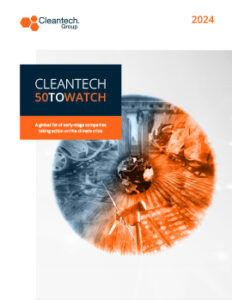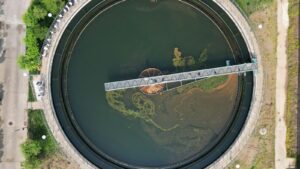Cleantech 50 to Watch Case Study: Inseco
Solution: Inseco develops a production system to transform organic waste into animal feed.
Nisa Mirza of Cleantech Group sat down with Inseco’s Co-Founder & CEO, Simon Hazell, to discuss what led up to Inseco becoming a Cleantech 50 to Watch company.

Simon Hazell, Co-Founder & CEO, Inseco
How did the company start?
Simon Hazell: It started on the waste management side. A good friend of mine has a vineyard where I spent my holiday observing the winemaking process. I noticed there was a bulk of grape pomace, which is all the parts of the grape that aren’t used to produce wine, constantly being created. Most of the grape pomace ends up getting picked up and dumped. From there, I became interested in wine waste beneficiation, which later drew my attention to food waste throughout the supply chain, particularly at the crop production level.
I realized that this was a major issue worldwide, especially in developing countries where cold chain transportation logistics networks are not particularly well established. As a result, you have a lot of pre-consumer waste that’s generated. Plus, it’s a huge contributor to greenhouse gases. Globally, I believe we generated 3.3B tons of food waste last year. If food waste were a country, it would be the third largest greenhouse gas emitter after the US and China.
Not only do we have a sustainability crisis, but we’ve not updated our technology in the last 100 years. It’s all landfall composting and wasting energy with the three key commercially available technologies at the time. And to a large extent, we’re adding value to the process. So, I started looking into alternatives, and that’s where I came across insect protein. I’d read about a few companies, and one of my lecturers at university educated me on it. I started investigating the industry and thought that it was quite compelling. I saw the opportunity to quit my job and invest some money in a small pilot plant — and four years later, here we are.
How do you make insect protein?
Simon Hazell: We look for organic byproducts. There are multiple types of food waste, and typically one thinks of the kind that the average household produces. However, we focus on cleaner streams such as pre-consumers. Think of manufacturing facilities, farms, etc., that generate byproducts from their facilities, like a juice factory, for example. Those waste streams get delivered to our facility and homogenized. So, we put it into heavy-duty machinery that shreds it and makes it uniform. Later, we treat it and pump it through the facility where it is converted into feedstock.
Simultaneously, we have a biological part of the process, which is where we have billions of black soldier flies that are in a temperature and humidity-controlled environment where they are induced to mate and lay eggs. Once the eggs are hatched, the neonates are introduced to the feedstock that has been prepared in the feed plant. This happens over a period of 12 days. The larvae consume everything in the bin, and they’re then harvested. What comes out is an organic fertilizer that has a number of beneficial properties. These live insects are finally sent to a processing plant where we take out the facts and dry the protein.
What applications does insect protein have?
Simon Hazell: We’re currently focused on animal feed, but there are various potential applications, from oil to protein meal. In fact, I personally consume the products quite often. It’s a fantastic source of protein and is hypoallergenic. To premeditate the common response I receive, there are a lot of things that we eat that we don’t quite understand where they come from. I challenge anyone to go spend a week in an abbatoir and then consume meat freely without any second guessing. At least that’s what happened to me. Furthermore, humans have found insects as a source of nutrition for centuries, from chapulines (fried crickets) in Mexico to traditional casu marzu (maggot cheese) in Italy.
Lastly, there is a less well-known cosmetic application for insect protein. When it is converted into an oil, we’ve found that it is very high in lauric acid. Currently, coconut oil and palm oil are the most prevalent sources of lauric acid in commercial applications such as skin rejuvenating products. So, in the future, we might see cosmetic and even pharmaceutical applications.

At what stage are you on the business end?
Simon Hazell: We are selling the products to various customers. Concurrently, we’re doing quite a bit of product development and market research. It’s a very new product class where there aren’t a lot of other companies in our markets that produce the protein meal and the oil. So, the customer profiles that we deal with are quite specific, and we have to kind of do all of that heavy lifting ourselves. The next iteration of the business is to build other plants like this and basically use the technology as a way to upcycle organic waste into sustainable and profitable insect products. Unfortunately, I cannot name names at this time, but suffice to say, we are working with local poultry and agricultural clients in South Africa and internationally.
How do you factor in the energy considerations for producing insect protein?
Simon Hazell: Great question. Fortunately, heating technology has come a long way, and we have a recycling element that we do with the heat that we generate. It is important to note that the carbon footprint of insect protein is considerably lower than alternative products. So, while there is an energy component to it, it’s substantially more greenhouse gas efficient than competing ingredients, which is a key part of the cost-effectiveness of the business.
We are in the process of installing solar roofing in all of our facilities, which will bring down energy consumption dramatically. But another potential business objective is to find areas where the climate is more tropical to reduce heating requirements. At the moment, our priority is full production in our Cape Town facility, where we have two projects in the pipeline with two existing companies. We’ll be building this next set of plants in other parts of Africa.
What challenges do you perceive for Inseco?
Simon Hazell: Beyond Western perceptions of insect protein, execution is complex at scale in a reliable and consistent manner. It’s an MCG environment with biological assets, so there are complexities around the production process itself. We’ve learned a lot there, and I think we’re on the precipice of really unlocking it and getting it right consistently. Moreover, fundraising is difficult outside of the U.S. and Europe, where capital markets are much deeper. And so, we’re very fortunate to have the investors that we have on board. They’re very much supportive of what we’re trying to achieve.
For more information, visit the Inseco website.



